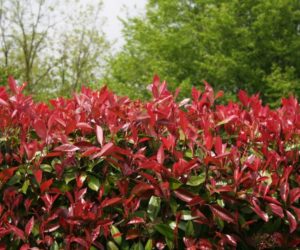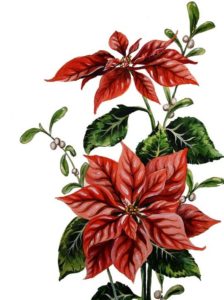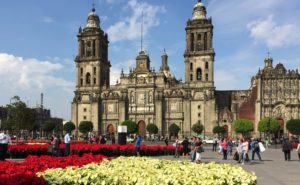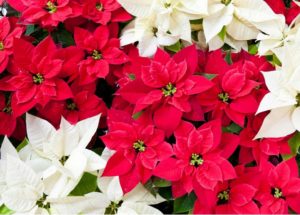Podcast: Play in new window | Download
Subscribe: Apple Podcasts | RSS
 The first US Minister to Mexico, Dr. Joel Roberts Poinsett, entered a small church in the town of Taxco. The date was Christmas Eve, 1826. Poinsett noticed that the Franciscan monks had decorated the church’s nativity scene with an exotic bright red flower he had never seen before. The American asked the monks the flower’s name and they told him, “Flor de Nochebuena,” or the Christmas Eve flower. They told him the story behind why the flower is red and why the Spanish named the plant Nochebuena. According to the legend, sometime in the 16th Century the Franciscan friars started evangelizing the area and set up their first nativity scene in a small church they had just built in the region. The friars decorated their nativity scene with a local flowering plant which had white leaves near its center. During the customary Christmas Eve mass, with the church filled to capacity with new converts to Christianity, all the flowers surrounding the nativity scene in the church suddenly turned red. From that point on, the plant was named the Nochebuena, the Christmas Eve Flower. When Poinsett examined the plant more closely, he noticed the flower part of the Nochebuena was quite small. The plant’s leaves closest to the small center flower are what give this quintessential symbol of Christmas its characteristic bright red. The US Minister, who was an amateur botanist, would later gather cuttings from wild Nochebuena plants he found on the side of the road and would send them back home to South Carolina for cultivation in his private greenhouse. The plant became known as the “Mexican flame flower” or “painted leaf.” By the time Poinsett shared this plant with America, the Europeans had already described the flower. Samples had been brought back to Europe with the return of the Alexander von Humboldt Expedition in 1804 and European horticulturists began growing the plant. The Germans gave it its scientific name, Euphorbia pulcherrima. As the popularity of the flower grew in the United States, nursery owners needed a new name for it. American historian and amateur botanist William Prescott, who wrote a widely read book called History of the Conquest of Mexico, gave the flower its current name, “poinsettia,” in 1836. Long before its English name or its Latin name, the recognizable symbol of Christmas had a name in Nahuatl, the language of the Aztecs. They called it the cuetlaxochitl.
The first US Minister to Mexico, Dr. Joel Roberts Poinsett, entered a small church in the town of Taxco. The date was Christmas Eve, 1826. Poinsett noticed that the Franciscan monks had decorated the church’s nativity scene with an exotic bright red flower he had never seen before. The American asked the monks the flower’s name and they told him, “Flor de Nochebuena,” or the Christmas Eve flower. They told him the story behind why the flower is red and why the Spanish named the plant Nochebuena. According to the legend, sometime in the 16th Century the Franciscan friars started evangelizing the area and set up their first nativity scene in a small church they had just built in the region. The friars decorated their nativity scene with a local flowering plant which had white leaves near its center. During the customary Christmas Eve mass, with the church filled to capacity with new converts to Christianity, all the flowers surrounding the nativity scene in the church suddenly turned red. From that point on, the plant was named the Nochebuena, the Christmas Eve Flower. When Poinsett examined the plant more closely, he noticed the flower part of the Nochebuena was quite small. The plant’s leaves closest to the small center flower are what give this quintessential symbol of Christmas its characteristic bright red. The US Minister, who was an amateur botanist, would later gather cuttings from wild Nochebuena plants he found on the side of the road and would send them back home to South Carolina for cultivation in his private greenhouse. The plant became known as the “Mexican flame flower” or “painted leaf.” By the time Poinsett shared this plant with America, the Europeans had already described the flower. Samples had been brought back to Europe with the return of the Alexander von Humboldt Expedition in 1804 and European horticulturists began growing the plant. The Germans gave it its scientific name, Euphorbia pulcherrima. As the popularity of the flower grew in the United States, nursery owners needed a new name for it. American historian and amateur botanist William Prescott, who wrote a widely read book called History of the Conquest of Mexico, gave the flower its current name, “poinsettia,” in 1836. Long before its English name or its Latin name, the recognizable symbol of Christmas had a name in Nahuatl, the language of the Aztecs. They called it the cuetlaxochitl.
The name cuetlaxochitl loosely translated into English means, “Flower that perishes like all that is pure.” There are a few different legends as to how the cuetlaxochitl came to be. According to the ancient Tlaxacalans, a Nahua-speaking people of central Mexico who were never conquered by the Aztecs, the story of the Christmas flower began with a beautiful princess. She was in love with a common man who treated her well and loved her as much as she loved him. The young woman’s parents forbade her from seeing him, and from her heartache sprang forth the beautiful red flower as a reminder of forbidden love.
 Another legend of the cuetlaxochitl tells of a time right before the Aztecs conquered the northern part of the modern Mexican state of Guerrero. This is around the area where Dr. Joel Poinsett was first introduced to the flower. The ancient people who lived around Taxco cultivated the poinsettia, which was sacred to them, and at the time, the flower was white. The powerful armies of the Aztecs easily annihilated the ragtag military of the people of Taxco leaving behind few survivors in the surrounding towns. The Aztecs then incorporated this territory into their vast empire. The October following this subjugation, those natives remaining in the area beheld an amazing sight: the cuetlaxochitl started turning red instead of white. To the locals, this was the way the ancient gods of Taxco memorialized those who perished at the hands of the invading Aztecs, so that no one, including the conquerors, would ever forget those who died.
Another legend of the cuetlaxochitl tells of a time right before the Aztecs conquered the northern part of the modern Mexican state of Guerrero. This is around the area where Dr. Joel Poinsett was first introduced to the flower. The ancient people who lived around Taxco cultivated the poinsettia, which was sacred to them, and at the time, the flower was white. The powerful armies of the Aztecs easily annihilated the ragtag military of the people of Taxco leaving behind few survivors in the surrounding towns. The Aztecs then incorporated this territory into their vast empire. The October following this subjugation, those natives remaining in the area beheld an amazing sight: the cuetlaxochitl started turning red instead of white. To the locals, this was the way the ancient gods of Taxco memorialized those who perished at the hands of the invading Aztecs, so that no one, including the conquerors, would ever forget those who died.
The flower was also somewhat sacred to the Aztecs themselves and was held in high esteem throughout their empire. As the cuetlaxochitl blooms from October to February, to the Aztecs, it symbolized a re-birth of light on mother earth during the winter months. The bright red flowers adorned temples to Huitzilopochtli, the Aztec god of the sun, of war and the patron and protector of the imperial capital of Tenochtitlán. The red leaves symbolized the blood of sacrifice and the sacred energy of the life force. The leaf pattern of the flower around its center focal point symbolized the rays of the sun. Because the poinsettia could not grow in the high altitudes surrounding Tenochtitlán, Aztec emperor Montezuma had an official botanical garden specifically dedicated to the cultivation of the cuetlaxochitl in Oaxtepec, in the modern-day Mexican state of Morelos. In the late fall, caravans of people carried the flowers in packs on their backs from 60 miles away so the Aztec capital could be properly decorated for the festivals to honor Huitzilopochtli. The early Spanish chroniclers who first encountered the Aztecs with Cortés marveled at the hundreds of men marching to the grand city laden with the beautiful bright red flowers.
 During the time the cuetlaxochitl was in the imperial capital, the Aztecs put the plant to good use, so the early Spanish eyewitnesses noted. The leaves were brewed into a tea for expectant mothers to increase the production of breast milk. The cuetlaxochitl leaves, combined with other herbs, made for powerful women’s medicine, but the exact amounts used in which kinds of mixtures for which different ailments is now lost knowledge. The Aztecs used the sap of the plant to blend into poultices to treat wounds and various skin conditions. As the cuetlaxochitl can grow to 10 feet tall and have a thick trunk, sometimes just the sap of the plant was tapped, gathered and imported into the areas in ancient Mexico where poinsettias could not grow. The Aztecs and other indigenous groups also used the dried leaves to make a red dye for textiles and for arts and crafts. The cuetlaxochitl was of no importance to the ancient Maya. The natural territory of the poinsettia was nowhere near the jungles of the Maya area and although they must have come across it through long-distance trade, the bright red Christmas flower was never part of their culture.
During the time the cuetlaxochitl was in the imperial capital, the Aztecs put the plant to good use, so the early Spanish eyewitnesses noted. The leaves were brewed into a tea for expectant mothers to increase the production of breast milk. The cuetlaxochitl leaves, combined with other herbs, made for powerful women’s medicine, but the exact amounts used in which kinds of mixtures for which different ailments is now lost knowledge. The Aztecs used the sap of the plant to blend into poultices to treat wounds and various skin conditions. As the cuetlaxochitl can grow to 10 feet tall and have a thick trunk, sometimes just the sap of the plant was tapped, gathered and imported into the areas in ancient Mexico where poinsettias could not grow. The Aztecs and other indigenous groups also used the dried leaves to make a red dye for textiles and for arts and crafts. The cuetlaxochitl was of no importance to the ancient Maya. The natural territory of the poinsettia was nowhere near the jungles of the Maya area and although they must have come across it through long-distance trade, the bright red Christmas flower was never part of their culture.
Throughout the colonial period, the Spanish continued the Aztec tradition and brought the cuetlaxochitl into sacred spaces to celebrate a winter holiday. Besides the legend told to US Minister to Mexico Joel Poinsett by the Taxco friars, there is another popular story in Mexico to this day which explains how the flower came to be. In a small rural town, a poor girl was distraught at having no gifts to give the Baby Jesus in her community’s annual Christmas procession. While she was crying by her bedside, an angel appeared to the girl and told her any gift would do as long as it was given with a loving heart. The young girl pulled some weeds that were growing by the side of the road and went to place them by the Baby Jesus in the town’s nativity scene. The other children mocked the girl for giving such a poor gift. As soon as she placed the weeds in front of the manger, a bright light appeared and miraculously turned the weeds into the red flower so recognizable today.
 When Dr. Joel Poinsett returned to the United States in 1829, some of the cuttings he had sent to friends in South Carolina a few years before were now flourishing. One of the plants was acquired by a nursery in Philadelphia that grew them in abundance and by the mid-1830s the flower was starting to be associated with Christmas. By the early 1900s, a man in California named Paul Ecke perfected a growing technique that caused the plants to branch. The Ecke nurseries pretty much cornered the market on the American production of poinsettias until the 1980s when other nurseries and private growers discovered the Ecke family secret. Today, in the United States, sales of poinsettias generate a quarter of a million dollars annually in retail sales.
When Dr. Joel Poinsett returned to the United States in 1829, some of the cuttings he had sent to friends in South Carolina a few years before were now flourishing. One of the plants was acquired by a nursery in Philadelphia that grew them in abundance and by the mid-1830s the flower was starting to be associated with Christmas. By the early 1900s, a man in California named Paul Ecke perfected a growing technique that caused the plants to branch. The Ecke nurseries pretty much cornered the market on the American production of poinsettias until the 1980s when other nurseries and private growers discovered the Ecke family secret. Today, in the United States, sales of poinsettias generate a quarter of a million dollars annually in retail sales.
Here are some more fun facts about the cuetlaxochitl aka poinsettia taken from the University of Illinois Urbana-Champaign web page devoted to the plant:
There are over 100 varieties of poinsettias available. Though once only available in red, there are now poinsettias in pink, white, yellow, purple, salmon, and multi-colors. They have names like ‘Premium Picasso’, ‘Monet Twilight’, ‘Shimmer’, and ‘Surprise’.
The red poinsettia still dominates over other color options. ‘Prestige Red’–one of many poinsettias patented by Ecke–ranks among the best-selling hybrids.
California is the top U.S. poinsettia-producing state.
Poinsettias are the best-selling potted plant in the United States and Canada.
Poinsettias are the most popular Christmas plant. Most Poinsettias are sold within a six-week period leading up to that holiday, representing some $60 million worth.
It is estimated that women account for 80% of Poinsettia sales.
 The most common question people have about Poinsettias is how to get them to rebloom in successive years.
The most common question people have about Poinsettias is how to get them to rebloom in successive years.
On July 22, 2002, the US Congress passed a bill declaring December 12th “Poinsettia Day” in the United States. Why the 12th of December? Joel Poinsett died on December 12, 1851. The 12th of December also just so happens to be a national holiday in Mexico, a day set aside to honor the Virgin of Guadalupe.
With its bright and red leaves, the cuetlaxochitl has come a long way since it was cultivated in ancient Mexico. Emperor Montezuma never would have guessed when inspecting the beautiful botanical gardens at Oaxtepec that such a beautiful plant would leave the confines of his empire and become a symbol of warmth and joy during the cold winter months, bringing delight to millions around the world.
REFERENCES
What’s the Poinsettia? http://www.aaaim.com/echo/v2n4/WhatsThePoinsettia.htm?fbclid=IwAR1EdZtOHorv8mLBITWGKbPNkuOjlS82AZ0BGCv6cGCrUxwykGIHh39vq6k
Curanderismo blog: https://www.curanderismo.org/post/cuetlaxochitl-poinsettia-a-gift-of-rebirth-and-light-from-mexico
The Poinsettia Pages: https://web.extension.illinois.edu/poinsettia/
